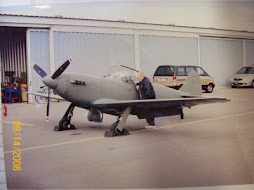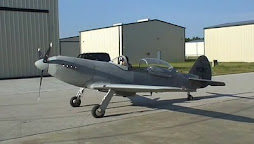This (pic) has really helped with the organization. These shelves are full of all the rudder, elevator, horz & vert stab, and some fuselage patterns. There are also some misc engine parts, gear parts, etc. but that will be sorted out as time goes by.

Here is a set of rolling shelves that were built to hold all of our hydraulic press patterns. These male/female dies are for pressing out bulkhead, wing rib, and some fuselage parts. The press is just on the other side of the wall to the right. Should be handy access for these heavy pieces.

WELL - FINALLY!!!! This is the humble start to our first Prowler. This is the first piece we cut from our heavy aluminum sheets. It's the center wing section main spar web. The jig saws all went south on us and they were slow anyway. I found the recip saw to be faster and easier to control and not drag shavings along to scratch the stock. It's still the HARD way to do this!

BTW - that's the "Old Master" back at it again. George just turned 80 years old recently. Wow.

This is the "somewhat" easier way to cut out all the spar pieces. We used George's metal band saw. It's somewhat easier, but it's becoming clear that there is no really "easy" way to cut this stuff quickly and practically (unless you have millions of $$ for the CNC 5' X 12' router tables).

This is laying out the fly cut for the torque tube hole in the end of the spar web. The torque tube for the gear will pass thru a bearing in this hole to support the top of the gear strut.

And... The fly cuts.

Here is the semi finished product.

What this makes is essentially an aluminum I-beam. The several laminations of strips at the top and bottom create the "flanges" and the shear web will hold it all together. When positive G's go on the wing, the top spar cap "flange" goes into compression and the bottom spar cap goes into tension. Negative G's have the oppisite effect. The whole assembly provides for the attachement of all the other wing components and gives the wing it's ultimate strength. Right now, all the pieces have rough sawed edges and must be clamped to spacer blocks and the original patterns. This assembly is then passed by a router that will clean up the edges and make the pieces all precisely the same as the original pattern. That will be the topic for the next post. Thanks for stopping by.



 This is laying out the fly cut for the torque tube hole in the end of the spar web. The torque tube for the gear will pass thru a bearing in this hole to support the top of the gear strut.
This is laying out the fly cut for the torque tube hole in the end of the spar web. The torque tube for the gear will pass thru a bearing in this hole to support the top of the gear strut. 





 This is laying out the fly cut for the torque tube hole in the end of the spar web. The torque tube for the gear will pass thru a bearing in this hole to support the top of the gear strut.
This is laying out the fly cut for the torque tube hole in the end of the spar web. The torque tube for the gear will pass thru a bearing in this hole to support the top of the gear strut. 








